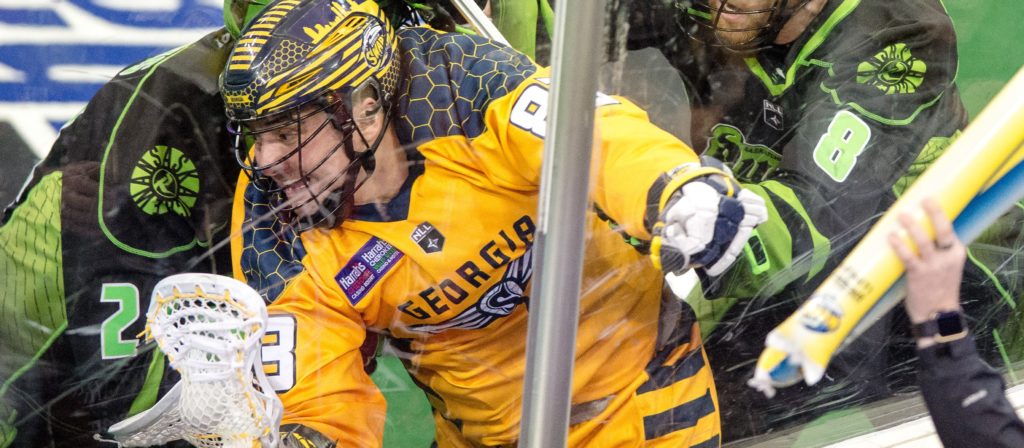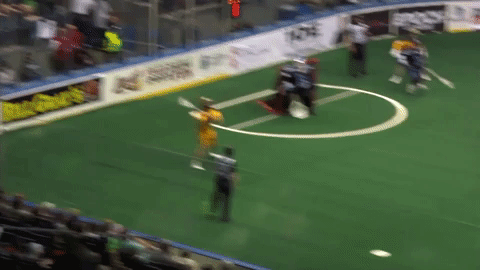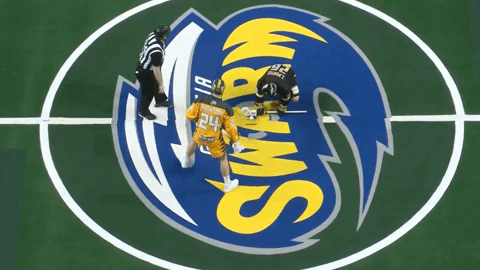Ready to learn about the indoor game? Let’s get started.
Indoor lacrosse, commonly known as box lacrosse or boxla, is an indoor version of lacrosse played inside a hockey rink with turf above the ice.
The object of the game is to score against your opponent and prevent said opponent from scoring.
Games consist of four 15-minute quarters and a 15-minute halftime, and the team with the higher score wins. If the two teams are tied at the end of regulation, they go into sudden death overtime.
Each team has an Active Roster consisting of 21 players. Before each game, the teams have to scratch two players, meaning those two will not play in the game that day.
Of the 19 players on a team who will dress, there have to be 17 runners (any position that isn’t goalie) and 2 goaltenders, and only 6 can be on the floor at any time.
Typically, you will see one goalie and five players playing offense or defense for a team at any given time.
Teams have 30 seconds to make a shot on goal. A team can reset the shot clock by regaining possession after a goalie makes a save, if the shot hits the posts of the goal, or if the shot hits the goalie/goal and goes out of bounds.
If they do not make a shot that hits the goal or goalie and the 30 seconds expire, then the ball is turned over to the other team.

Not exactly. The basic lacrosse elements are the same: you have three runner positions (attack=forward, defenseman, middie=transition) and goalies, and the ultimate goal is to score more than your opponent.
There are picks, seals, crease violations, penalties, and more, but the similarities tend to end around there. A lot of it has to do with the biggest difference between the two versions of lacrosse: space.
Boxla takes place in a much smaller area than field, around 2,800 less square foot. Players have less room to operate in and have to move quickly to get a shot off within 30 seconds.
Add the boards around the floor confining the action, and you get a very frantic, up-close-and-personal version of lacrosse.

Players also have to keep their heads on a swivel as the indoor game is much more physical than the outdoor one. There’s a saying that there’s no such thing as a moving pick in box, and it’s pretty much true.
In field, a player has to be stationary when setting a pick (putting their body in the way of a defender to separate them from their assignment).
Referees in box tend to let moving picks slide, so a player could receive a check to their back at any moment and have to be ready at all times.
Another thing you won’t see too much of is players swapping the stick to their off-hand.
Righties shoot with their right hands, lefties with their left. With the time and space boxla players work with, swapping hands like in field very rarely happens.
That said, stick skills are sharper in box than field. Players have to get their sticks free to make unconventional shots and stops, so their stick-handling abilities are the best in the world.
If you’ve seen a field lacrosse game before, then you’ll pick up on the intricacies of indoor lacrosse very quickly.
If you’ve ever watched a sport before, you’ll intuitively understand the action on the field, just maybe not the nuts and bolts of it.
Box lacrosse is very accessible, entertaining, and non-stop.
A goal is scored whenever the ball crosses the line at the base of the net and enters the plane behind the goalie.
This means that even if the net is unintentionally removed from its moorings, a ball that enters where the goal should have been will still be counted as a good goal.
The ball must have entered this area before the 30-second shot clock expires.
The area surrounding the goal – the crease – cannot have a player in it before the ball crosses that plane. Players cannot bat or kick the ball into the goal and cannot shoot the ball at a goalie’s back to ricochet the ball into the net.

The crease is the goalie’s home, and opposing players trying to score – referenced as an attacking player for the remainder of this section – cannot have any part of their body touch the circular boundary.
An attacking player who has the ball cannot enter the crease. If they do, the play is blown dead by the referee, and possession changes to the other team.
If an attacking player has any part of his body touch the crease before the ball crosses the goal plane, that goal is waived due to a crease violation.
If an attacking player makes a shot from outside the crease but a teammate is in the crease, the goal is again waived due to a crease violation.
The following clip demonstrates a crease violation. Shayne Jackson on the right had his toes on the crease when he made shot the ball in for a goal, and the goal was waived because of that.

Players trying to score, however, aren’t the only ones that can’t enter the crease.
An attacking player without the ball that steps in the crease cannot receive the ball as they are deemed to have gained an advantage. The ball must be passed to a different player before that off-ball attacking player who entered the crease can receive a pass.
If a defending player receives the ball outside of their crease, they cannot enter the crease to begin their transition, as they are deemed to have gained an advantage.
One final fact regarding the crease: while the goaltender is in the crease and has possession of the ball, an attacking player cannot make contact with the goalie nor his stick.
There are exceptions to this, like if a defender hits an attacking player, and that hit causes the attacking player to make contact with the goalie.
All games start with a face-off. Similar to a tip-off in basketball, two opposing players will kneel down in the center of the floor and try and gain possession of the ball.
The rest of the players on the floor must be behind the restraining lines between the goals and middle of the floor.
After a team scores a goal, two players will immediately meet again in the center of the floor for another face-off.
A face-off will also take place at the beginning of each quarter and overtime.
If a player commits a face-off violation, then the ref will blow his whistle to call the play dead and award the ball to the team which did not commit a violation.
The following are considered face-off violations:

Teams get one timeout per half, two total per game. If a game goes into overtime, teams will receive one additional timeout.
Timeouts not used in the first half do not carry over into the second half. Timeouts run 45 seconds.
For a team to use a timeout while there is action on the floor, they must have possession of the ball.
When there has been a stoppage in play, either team can use their timeout.
Referees can call timeouts for injured players, and neither team will be charged a timeout.
Every quarter has two promotional timeouts, typically under the 10-minute and 5-minute marks.
